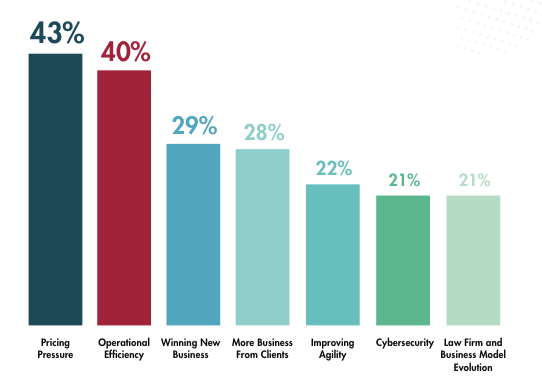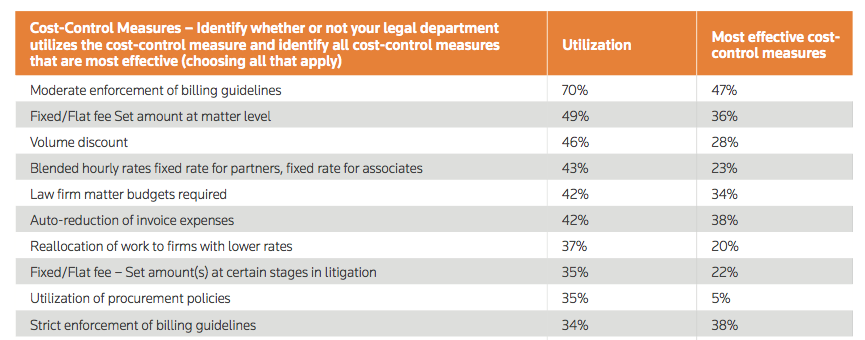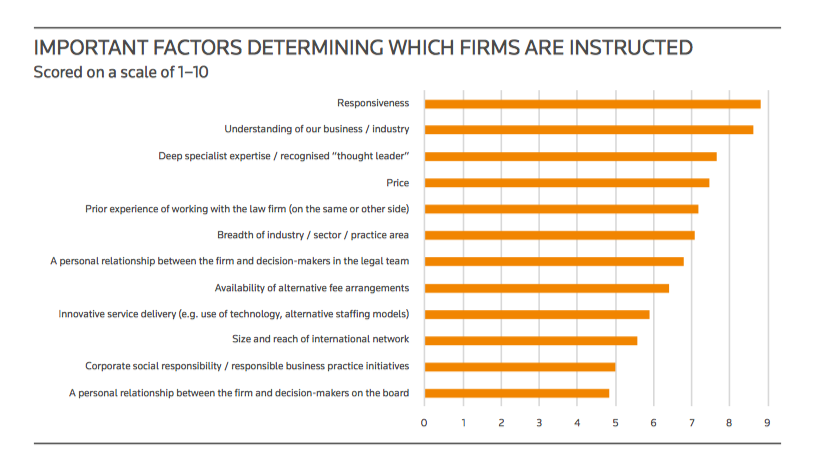We can now make a very strong case for the growing importance of tech-enabled law practice. Of course, all law firms and law departments have technology. But mere infrastructure no longer suffices. Rather, lawyers must move to tech-enabled law practice to improve efficiency.
Two developments prompted me to write this now. First, ILTACon 2017 starts Sunday – it’s the best place to learn how to tech-enable law practice. And second, many studies conclude that firms must improve service delivery with lower cost, more accurate budgets, faster client responsiveness, and deeper understand of companies and industries.
So let’s take a look at some recent studies, then turn to ways to tech-enable law practice.
What Recent Legal Market Studies Tells Us
The 2017 Aderant Business of Law and Legal Technology Survey, released this month, found law firms face rate price pressure and operational efficiency as their two biggest challenges:

These are the flip side of delivering legal advice at lower cost. So firms are aware. Many have yet to act in ways that really change how lawyers work.
The Thomson Reuters Legal Tracker Report, released in June, examined the client perspective. A survey of law department operations (LDO) professionals found they use a range of cost control measures. The table below shows some approaches (I have only reproduced a portion of the table). Billing guidelines, fixed fees, discounts, budget, and the search for lower rates top the chart. We should expect more law departments to adopt these measures over time. And expect that LDOs will improve the effectiveness of those measures. A quick study of the table suggests firms will continue to face economic pressure:

Clients want more than lower cost; they also want firms that respond quickly and have a deep understanding of their business and industry. In May, Thomson Reuters published a survey of UK large clients, Standing Out from the Crowd. It shows that responsiveness and understanding business / industry as the top two factors clients consider in selecting firms, followed by expertise and price.

How Tech-Enabled Law Practice Meets Client Demands
Many technologies enable lower cost delivery, budgeting, fee analysis, rapid communication, and understanding companies and industries. Let’s start with artificial intelligence, then turn to some other new categories of legal tech, and finally look at a few example of mature technology that still add value in building a tech-enabled law practice.
The Promise of Artificial Intelligence. I view the volume of AI discussion as a mixed blessing. On the one hand, AI has management and executive committees talking about tech and sometimes even transformation. And it has many practical applications today. On the other hand, it distracts attention from many other, equally important technologies for practice and business efficiency.
AI Today. AI already boosts practice efficiency in several ways:
- Document review in discovery is the longest standing and most widespread one.
- Contract analytics, especially to accelerate due diligence in deals, is growing rapidly. Kira Systems, one of several competitors in contract analytics, has over 200 law firm licensees and works on over 1000 projects concurrently each month (see August 9 press release).
- Several products assist law firms and clients analyze and characterize time entries and/or matters.
- Multiple providers apply AI to public law to draw new and valuable views on it for legal research.
The Potential of AI to Transform Core Law Practice. My Fireman & Company colleagues and I believe that AI will also play a big role enhancing core law practice – working with documents and email. In a white paper we released today, Transforming How Lawyers Work: AI-Enabled Document Management, we explain our view that the combination of RAVN and iManage will transform law practice. In it, we note the convergence of three key 2017 trends – AI explosion, enterprise search moving from 2D to 3D, and document management (DM) transforming from an application to a platform. We conclude:
“Embedding AI in DM will make DM “smarter” and cause barriers to DM adoption to fall away. Lawyers will experience a more personalized form of organic matter management and the system will enable new levels of practice-centricity. In short, DM will work the way lawyers want to work. AI functionality, working transparently behind the scenes, will surface useful information – people, content and connections – when and where it is needed based on work that a lawyer is performing and her role on the matter team.”
Beyond AI: Other New Categories of Legal Tech. Beyond AI, search, and DM, many other technologies support more efficient legal service delivery:
- A leading and relatively new category is legal project management software. LPM systems help budget, price and manage matters. Ideally, they help firms, over time, delegate work to lower cost resources rather than just change the price and continue delivering the same old way.
- Intranets are new again! Too many law firm Intranets remain relics of the past. A modern Intranet helps lawyers manage matters. (So yes, this relates to LPM.) Financial dashboards show lawyers simple visuals that help manage clients and matters. Active matter management is key to delivery at lower cost. [As I commented at the Fireman & Company website, the Aderant acquisition of Handshake Software is good news. It will lead to even more powerful visual dashboards powered by Handshake.]
- Another relatively new (or perhaps just improved) category is deal management software, which helps coordinate the multiple documents in any bigger corporate transaction.
Many Older Product Categories Still Have Much Potential. We need not restrict ourselves to AI and new categories of software. Here are examples of more mature technologies that play or should play a big role:
- Customized news feeds have improved over the last decade and play an increasingly important role in helping lawyers understand their client companies and industries in which they work.
- Document assembly was available in the 1980s. Anecdotally, it seems finally to be gaining a bit more traction with the pressure for efficiency.
- One of my favorites but sadly still little-used software is to create and manage decisions trees to help understand litigation and estimate its settlement value.
Conclusions About Tech-Enabled Law Practice
Clients have spoken to their outside counsel: deliver service at lower cost. A much higher percent of legal work is fee sensitive than many partners understand. Over time, firms must change how they work to prosper. Fortunately, legal technology has evolved rapidly in the last few years and so can tech-enabled law practice to have a dramatically positive impact on efficiency. ILTACon is a great conference to learn about the options.
[If you would like to discuss the ideas here and learn more about how to tech-enable your law practice, I will be at ILTA. Contact me.]

Archives
Blog Categories
- Alternative Legal Provider (44)
- Artificial Intelligence (AI) (57)
- Bar Regulation (13)
- Best Practices (39)
- Big Data and Data Science (14)
- Blockchain (10)
- Bloomberg Biz of Law Summit – Live (6)
- Business Intelligence (21)
- Contract Management (21)
- Cool Legal Conferences (13)
- COVID-19 (11)
- Design (5)
- Do Less Law (40)
- eDiscovery and Litigation Support (165)
- Experience Management (12)
- Extranets (11)
- General (194)
- Innovation and Change Management (188)
- Interesting Technology (105)
- Knowledge Management (229)
- Law Department Management (20)
- Law Departments / Client Service (120)
- Law Factory v. Bet the Farm (30)
- Law Firm Service Delivery (128)
- Law Firm Staffing (27)
- Law Libraries (6)
- Legal market survey featured (6)
- Legal Process Improvement (27)
- Legal Project Management (26)
- Legal Secretaries – Their Future (17)
- Legal Tech Start-Ups (18)
- Litigation Finance (5)
- Low Cost Law Firm Centers (22)
- Management and Technology (179)
- Notices re this Blog (10)
- Online Legal Services (64)
- Outsourcing (141)
- Personal Productivity (40)
- Roundup (58)
- Structure of Legal Business (2)
- Supplier News (13)
- Visual Intelligence (14)

